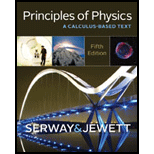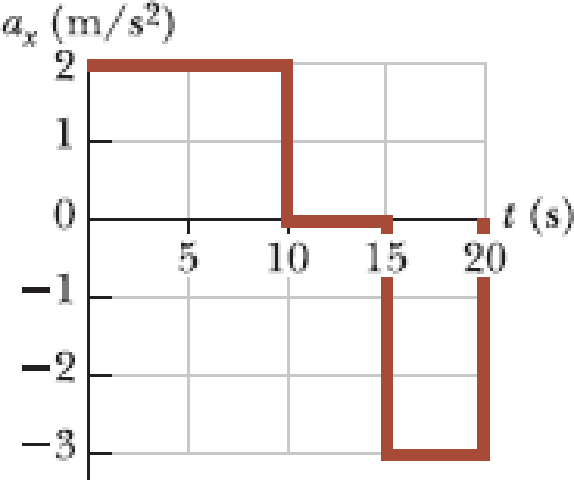
Concept explainers
A particle starts from rest and accelerates as shown in Figure P2.13. Determine (a) the particle’s speed at t = 10.0 s and at t = 20.0 s, and (b) the distance traveled in the first 20.0 s.

(a)
The particle’s speed at
Answer to Problem 13P
The particle’s speed at
Explanation of Solution
Write the equation for the final velocity of a particle.
Here,
The area under acceleration versus time graph under specific time intervals gives the change in velocity of the particle during the time interval. Speed is the magnitude of velocity.
The sides of a unit rectangle in the graph are
The area under the graph in the interval
Since the particle starts from rest, its velocity at
Substitute
The area under the graph in the interval
Substitute
Conclusion:
Therefore, the particle’s speed at
(b)
The distance travelled in the first
Answer to Problem 13P
The distance travelled in the first
Explanation of Solution
The area under velocity versus time graph under specific time intervals gives the displacements during the time interval.
In part (a), it is found that the velocity at
The velocity versus time graph is shown below.

The area from
Write the equation for the area of a triangle.
Here,
In figure 1, the base of the triangle from
Substitute
Here,
The area from
Write the equation for the area of a rectangle.
Here,
In figure 1, the length of the rectangle from
Substitute
Here,
The area from
In figure 1, the base of the triangle from
Substitute
Here,
In figure 1, the length of the rectangle from
Substitute
Here,
Write the equation for total distance travelled.
Here,
Conclusion:
Substitute
Therefore, the distance travelled in the first
Want to see more full solutions like this?
Chapter 2 Solutions
Principles of Physics
- A jogger jogs from one end to the other of a straight track in 1.03 min and then back to the starting point in 1.44 min. What is the jogger's average speed at the following points? (Assume the track is 100 m long.) (a) in jogging to the far end of the track m/s (b) coming back to the starting point m/s (c) for the total jog m/sarrow_forwardA European sports car dealer claims that his product will accelerate at a constant rate from rest to a speed of 100 km/hr in 8.00 s. What is the speed after the first 4.00 s of acceleration? (Hint: First convert the speed to m/s.)arrow_forwardIf the brakes on a car can give the car a constant negative acceleration 2k m/s^2 where k is positive constant. What is the greatest speed it may be going if it is necessary to be able to stop the car within 25 meters after the brakes are applied Choices: A) 20/✓k m/s B) 5k m/s C) 10✓k m/s D) 25k^2 m/sarrow_forward
- A car travels at 15 m/s for 10 s. It then speeds up with a constant acceleration of 2.0 m/s2 for 15 s. At the end of this time, what is its velocity? E) No answer A) 15 m/s D) 375 m/s C) 45 m/s B) 30 m/sarrow_forwardA car’s velocity as a function of time is given by vx= t2 = a + bt2, where a = 3.00 m/s and b = 0.100 m/s3. (a) Calculate the average acceleration for the time interval t = 0 to t = 5.00 s. (b) Calculate the instantaneous acceleration for t = 0 and t = 5.00 s.arrow_forwardWhile entering a freeway, a car accelerates from rest at a rate of 2.8 m/s2 for 14.5 s. How far does the car travel in those 14.5 s, in meters? And what is the car's final velocity, in meters per second?arrow_forward
- June walks for 15 minutes at 0.165 km/ min but then she remembers she is suppose to meet her friend at the end of the path in 20 minutes. If the path is 5.2 km long what speed does she need to run within the last 20 minutes in order to be on time?arrow_forwardA snowboarder on a slope starts from rest and reaches a speed of 4.4 m/s after 9.4 s. (a) What is the magnitude of the snowboarder's average acceleration in m/s2(b) How far does the snowboarder travel in this time in marrow_forwardA car accelerates from rest at 2.5 m/s2, travels with a constant velocity of 90 km/h and then decelerates at 3.0 m/s2 before coming to rest. If the total distance traveled is 500 m, what distance is the car traveling with constant velocity?arrow_forward
- The velocity-versus-time graph for a car driving down a straight road is shown. How far does the car travel during the time interval from t = 0 s to t = 4.0 s?A. 10 m B. 20 m C. 40 m D. 60 marrow_forwardA racing car starts from rest at t = 0 and reaches a final speed at time t. II the acceleration of the car is constant during this time, which of the following statements are true? (a) The car travels a distance t. (b) The average speed of the car is /2. (c) The magnitude of the acceleration of the car is /t. (d) The velocity of the car remains constant, (e) None of statements (a) through (d) is true.arrow_forwardFigure P2.15 shows a graph of vx versus t for the motion of a motorcyclist as he starts from rest and moves along the road in a straight line. (a) Find the average acceleration for the time interval t = 0 to t = 6.00 s. (b) Estimate the time at which the acceleration has its greatest positive value and the value of the acceleration at that instant. (c) When is the acceleration zero? (d) Estimate the maximum negative value of the acceleration and the time at which it occurs. Figure P2.15arrow_forward
 College PhysicsPhysicsISBN:9781305952300Author:Raymond A. Serway, Chris VuillePublisher:Cengage Learning
College PhysicsPhysicsISBN:9781305952300Author:Raymond A. Serway, Chris VuillePublisher:Cengage Learning Physics for Scientists and Engineers with Modern ...PhysicsISBN:9781337553292Author:Raymond A. Serway, John W. JewettPublisher:Cengage Learning
Physics for Scientists and Engineers with Modern ...PhysicsISBN:9781337553292Author:Raymond A. Serway, John W. JewettPublisher:Cengage Learning Principles of Physics: A Calculus-Based TextPhysicsISBN:9781133104261Author:Raymond A. Serway, John W. JewettPublisher:Cengage Learning
Principles of Physics: A Calculus-Based TextPhysicsISBN:9781133104261Author:Raymond A. Serway, John W. JewettPublisher:Cengage Learning Physics for Scientists and Engineers, Technology ...PhysicsISBN:9781305116399Author:Raymond A. Serway, John W. JewettPublisher:Cengage Learning
Physics for Scientists and Engineers, Technology ...PhysicsISBN:9781305116399Author:Raymond A. Serway, John W. JewettPublisher:Cengage Learning Physics for Scientists and Engineers: Foundations...PhysicsISBN:9781133939146Author:Katz, Debora M.Publisher:Cengage Learning
Physics for Scientists and Engineers: Foundations...PhysicsISBN:9781133939146Author:Katz, Debora M.Publisher:Cengage Learning




